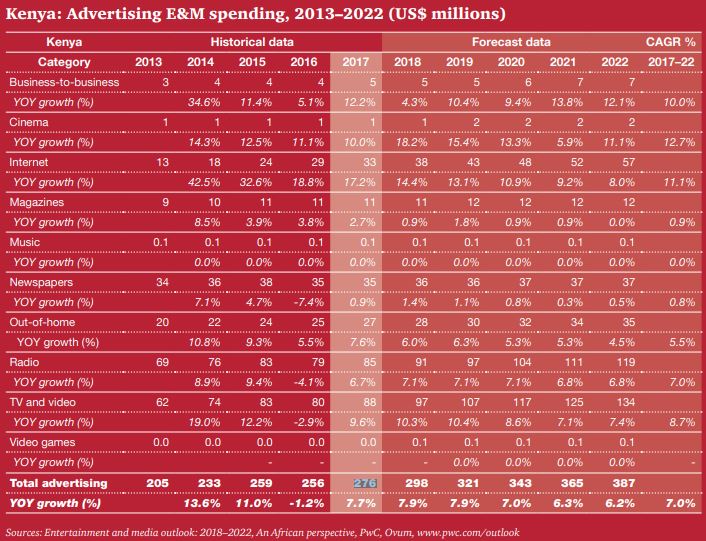TV and, notably, radio advertising revenue remain the leading lights in Kenya, accounting for Ksh 17.5 billion (US$173 million) of the Ksh 28 billion (US$276 million) total revenue in 2017. This overall advertising market will rise to Ksh 39 billion (US$387 million) at a 7.0% compound annual growth rate (CAGR) to 2022, PwC’s Entertainment and Media Outlook: 2018–2022, An African perspective (Outlook) projects.
PwC, however, says Kenyan advertising revenue has been restated in the Outlook following discussions regarding the scale of discounts given in the market.
It says although the pay-TV market has continued to expand rapidly, advertisers have continued to favour the terrestrial channels because of the guaranteed larger audiences.
“Although this share will fall back to 2022, due to growth in multichannel services, it will remain extremely dominant. Longer-term, as disposable incomes grow and broadband coverage improves, advertisers will look to more multiplatform campaigns to drive online traffic, but addressable advertising is some way off,” says the report.
In radio, Radio Africa Group launched its Market Plus 2018 radio advertising package in April 2018.
The package offers multi-platform advertising across the group’s stations, which include Kiss FM, Radio Jambo and Relax FM. It also offers advertising online and in The Star newspaper, which is owned by the group.
“This hybrid advertising package demonstrates that businesses are increasingly looking to invest in
advertising campaigns that stretch across multiple media formats, targeting consumers wherever they are and whatever they are doing. A healthy advertising market is a leading indicator of a promising Entertainment and Media (E&M) industry; Kenya’s advertisers will be keen to target the growing number of consumers with increased disposable income over the next five years as the country develops its growth story,” PwC notes in its Outlook.
The report says Kenya’s well-advanced mobile payments technology, M-Pesa, is normalising the idea of paying for goods or services via a phone, which makes the increasing access to mobile Internet positive news for the E&M industry. For example, the uptake of SVOD services as yet has been low as upon launch they only allowed the use of credit cards and PayPal for payment, hence limiting uptake to high-end subscribers.
“Service providers are keen to develop advanced mobile payment solutions like near-field communication to enable international remittances and payments for goods and services. As disposable incomes improve, the digital E&M industry will also experience an uptick. Outside the Internet space, TV and video revenue dwarfs the other segments,” it adds.

PwC notes that Kenya is among the few markets on the continent that have successfully completed the digital switch over, which has opened up new opportunities, resulting in the launch of new free-to-air community TV channels and the emergence of new local and international digital
content providers.
In terms of market dynamics, MultiChoice has continued to lose market share due to increased
competition from new entrants in the pay-TV segment who offer slightly lower prices for their subscription packages.
READ: PUEA’S NIGHTMARE AS STUDENTS DECLINE TO JOIN MKU, BARATON
In addition, MultiChoice is competing on premium sports content broadcasting with new entrants
such as Kwese TV and StarTimes which offer slightly lower monthly subscription packages. Though
relatively nascent for now, the inevitable growth in OTT means that traditional TV service providers will have to adopt new models to deliver TV content to their customers in order to counter the increased competition.












2 Comments